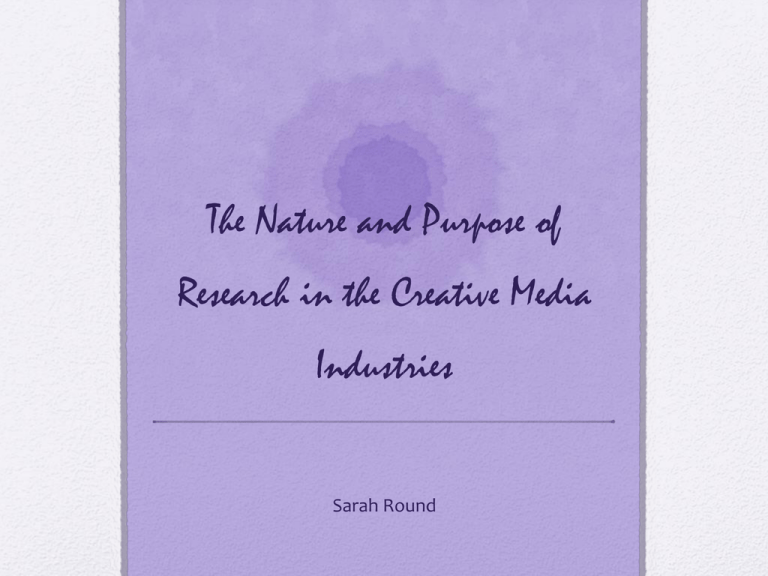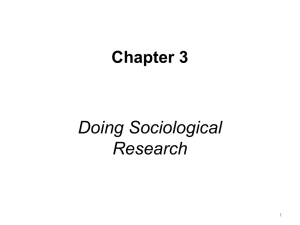The Nature and Purpose of Research in the Creative Media Industries
advertisement

The Nature and Purpose of Research in the Creative Media Industries Sarah Round Primary Data Primary data is valuable information you obtain yourself for a query or hypothesis. This data can be collated by asking questions, maybe via a questionnaire or survey, and conducting trials. Big questions may be asked in the filming Industry on certain elements of a movie. These can be tested by trial screenings. For example: (Tvtropes.org) DreamWorks questioned including the loss of Hiccups leg in How to Train your Dragon. Of course to some this may be upsetting but the audience took a liking to it and encourage it to be kept in the movie. Surveys are used to acquire information from a section of a population. Surveys are usually for topics that are quite general, though would be tricky to ask everyone. Here is a survey on people’s general internet usage. http://www.surveymonkey.com/s/general-internet-usage-template This could help with advertisement of a project, if people generally used the internet a lot then it would be seen as a good method to use. Also on how to execute the ad’ as popular as possible. Analysing previous work Primary data can be acquired at analysing past projects similar to the one in preparation, market data. This will help see what elements work with the target audience, and also see what is missing from ‘the scene’. Advantages The information will be more reliable to the focus. The amount of data should me more acquirable. Disadvantages Takes more time and planning May not be feasible, too hard to conduct a proper investigation Secondary Data Secondary data collected information for a pass cause which can be used for other projects. Secondary can be found in textbooks, or records of some kind; For example the census could help provide valuable data. But really you can find secondary data most places that store data. There are websites which provide loads of secondary data on television subjects such as the size of the audience for a programme, or what channel has the biggest audience. BARB, Broadcaster's Audience Research Board, is one of these sites. Here is a table showing the the most popular TV shows on 4Music on 7th Sep’ 2014. This could help a producer to see what the audience of 4Music like the best to see if it would be beneficial to publish their show on that channel. Advantages It takes less time to collect, easier to access, and it’s cheaper than primary data Disadvantages May not be completely appropriate or accurate enough. There will be a lack of control of the data. Quantitative Data Quantitative data is data that is usually numerous, it’s something that can be measured. These statistics are usually very clear, and straight to the point. There is usually one area of investigation, so only one group of information. Here is quantitative data on how many people listen to the radio in the space of half a year. This presents multiple quantitative data in a infographic, showing that the majority of the UK tune into the and shows which time of the year they listen to the radio the most. This could help someone in the media industry as radio can help promote a piece, therefor you would plan to publish it at a time that many people are listening. Also if they have the time to listen to the radio a lot they may have more time to watch TV. Advantages Easy to organize and analyze. Correlations are found easier. Disadvantages Lack information on the cause. The bigger the number of results the better, therefor takes more time to gather results. Qualitative Data Qualitative data is data that cannot be measured, it is more concerned with something non numerical, for example someone’s opinion on a statement. There aren’t websites to gather secondary information as easily for qualitative data as it is very sensitive and precise to the cause. It is data that is more helpful when researched primarily. Here is a table I found, it has 5 people and includes 7 pieces of information, these are qualitative as they are pieces of personal information. This kind of information is necessary to research as it helps you understand your target audience better. These pieces of information can help you determine what to feature from the age range, what time to put it on depending on the occupation and if subtitles are needed, the table suggests English is their second language. Advantages ‘Freedom’ to investigate more on the subject. Presents more detailed information. Helps with social causes, such as media, as it looks at opinions. Disadvantages Time consuming. The data’s meaning can be interpreted differently. Data Gathering Agencies Data Gathering agencies are what it says, they ‘gather’, collect, data for things such as media audiences. Two of these agencies that are helpful to Media are: National Readership Survey (NRS) This website provides information on the amount of audience for newspapers and magazines. It provides the number of audience, audience of different ages and how the audience views the page. Here’s an example of the later. Radio Joint Audience Research Limited (RAJAR) They provide the statistics of the UK audience for 310 radio stations. Again they may present the data in age groups, this website also states where the audience are (but subscription is necessary). This data is presented in infographics like - Audience Research Audience profiling is finding out the economic and social characteristics of the target audience. Demographics is the study of factors from a population such as age, gender, employment, ect. Geodemographics concentrate on demographics of a population in a specific geographical area. Using demographics are helpful as they help the researcher determine the target audience and how big that audience may be, as well as other factors that could effect the target audience. Audience Research Psychographics are the study of people based on the personality, aspiration and other psychological areas. Both demographics and psychographics are helpful in audience research as they help you understand your target audience better: who’s in the audience, how much they may invest, what they want, what they need, how it may effect their lives. Market Research Market research is gathering information about the audiences’ needs and preferences, however unlike audience research this information is gathered by looking at other products, or services ect, the audience like and dislike. The information collected about the competitors will consist of figures such as what the product or service is, how popular it is, reviews, pricing, location. Basically information that effects the target audience. In this article from Qualtrics.com it explains how Coke apparently lost millions from releasing “New Coke” but the wrong or lack of marketing research lead them in the wrong direction. So this is very important as if you don’t research enough or in the right ‘area’ it could lead the final result to not be as successful as expected. Thank You For Reading







